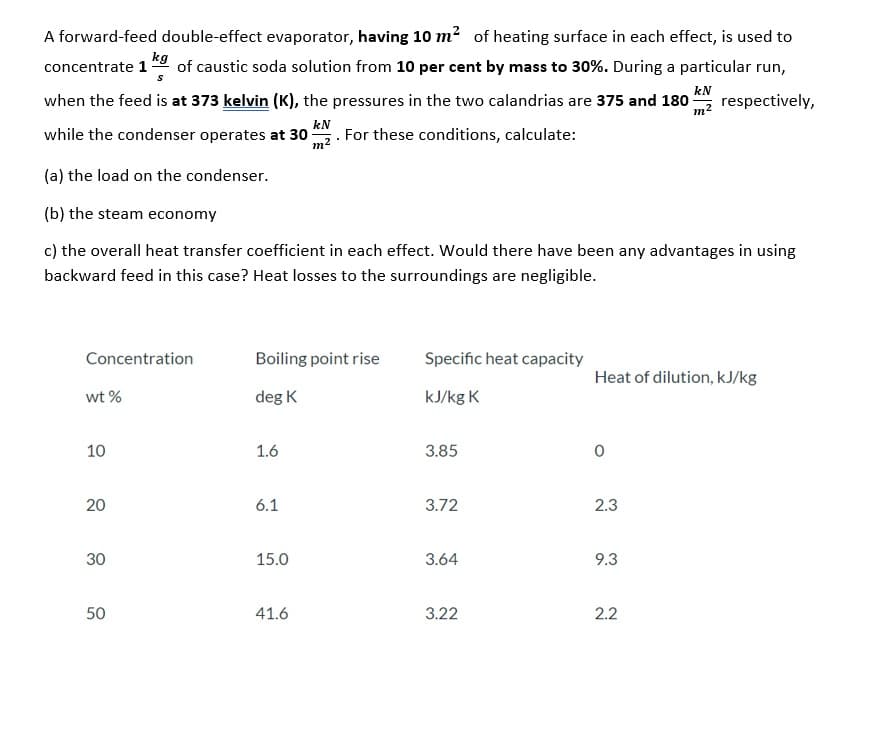A forward-feed double-effect evaporator, having 10 m? of heating surface in each effect, is used to kg of caustic soda solution from 10 per cent by mass to 30%. During a particular run, concentrate 1 kN when the feed is at 373 kelvin (K), the pressures in the two calandrias are 375 and 180 respectively, while the condenser operates at 30 kN For these conditions, calculate: m2 (a) the load on the condenser. (b) the steam economy c) the overall heat transfer coefficient in each effect. Would there have been any advantages in using backward feed in this case? Heat losses to the surroundings are negligible. Concentration Boiling point rise Specific heat capacity Heat of dilution, kJ/kg wt % deg K kJ/kg K 10 1.6 3.85 20 6.1 3.72 2.3 30 15.0 3.64 9.3 50 41.6 3.22 2.2
A forward-feed double-effect evaporator, having 10 m? of heating surface in each effect, is used to kg of caustic soda solution from 10 per cent by mass to 30%. During a particular run, concentrate 1 kN when the feed is at 373 kelvin (K), the pressures in the two calandrias are 375 and 180 respectively, while the condenser operates at 30 kN For these conditions, calculate: m2 (a) the load on the condenser. (b) the steam economy c) the overall heat transfer coefficient in each effect. Would there have been any advantages in using backward feed in this case? Heat losses to the surroundings are negligible. Concentration Boiling point rise Specific heat capacity Heat of dilution, kJ/kg wt % deg K kJ/kg K 10 1.6 3.85 20 6.1 3.72 2.3 30 15.0 3.64 9.3 50 41.6 3.22 2.2
Principles of Heat Transfer (Activate Learning with these NEW titles from Engineering!)
8th Edition
ISBN:9781305387102
Author:Kreith, Frank; Manglik, Raj M.
Publisher:Kreith, Frank; Manglik, Raj M.
Chapter9: Heat Transfer With Phase Change
Section: Chapter Questions
Problem 9.3DP
Related questions
Concept explainers
Heat Exchangers
Heat exchangers are the types of equipment that are primarily employed to transfer the thermal energy from one fluid to another, provided that one of the fluids should be at a higher thermal energy content than the other fluid.
Heat Exchanger
The heat exchanger is a combination of two words ''Heat'' and ''Exchanger''. It is a mechanical device that is used to exchange heat energy between two fluids.
Question

Transcribed Image Text:A forward-feed double-effect evaporator, having 10 m2 of heating surface in each effect, is used to
kg
concentrate 1 of caustic soda solution from 10 per cent by mass to 30%. During a particular run,
kN
when the feed is at 373 kelvin (K), the pressures in the two calandrias are 375 and 180-
respectively,
m2
while the condenser operates at 30
m2
kN
For these conditions, calculate:
(a) the load on the condenser.
(b) the steam economy
c) the overall heat transfer coefficient in each effect. Would there have been any advantages in using
backward feed in this case? Heat losses to the surroundings are negligible.
Concentration
Boiling point rise
Specific heat capacity
Heat of dilution, kJ/kg
wt %
deg K
kJ/kg K
10
1.6
3.85
6.1
3.72
2.3
30
15.0
3.64
9.3
50
41.6
3.22
2.2
20
Expert Solution
This question has been solved!
Explore an expertly crafted, step-by-step solution for a thorough understanding of key concepts.
This is a popular solution!
Trending now
This is a popular solution!
Step by step
Solved in 2 steps

Knowledge Booster
Learn more about
Need a deep-dive on the concept behind this application? Look no further. Learn more about this topic, mechanical-engineering and related others by exploring similar questions and additional content below.Recommended textbooks for you

Principles of Heat Transfer (Activate Learning wi…
Mechanical Engineering
ISBN:
9781305387102
Author:
Kreith, Frank; Manglik, Raj M.
Publisher:
Cengage Learning

Principles of Heat Transfer (Activate Learning wi…
Mechanical Engineering
ISBN:
9781305387102
Author:
Kreith, Frank; Manglik, Raj M.
Publisher:
Cengage Learning